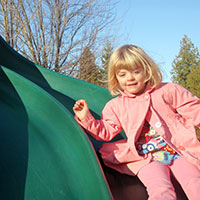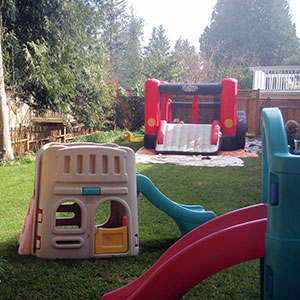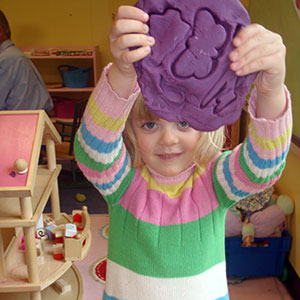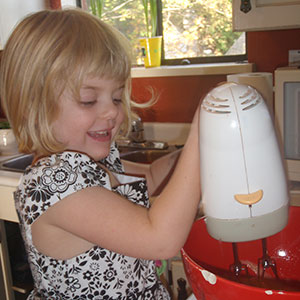 Every child is unique and special. They see the world from their own perspective, and often don’t understand why we do things the way we do. It is our job to help guide them so they can successfully navigate their world and get along with others. My goal is to teach them in a gentle fashion what it means to respect others, respect the environment, and respect equipment. It is a continual conversation; a process that involves both preventive and intervening strategies. My day care is set up in a way that encourages cooperative play.
Every child is unique and special. They see the world from their own perspective, and often don’t understand why we do things the way we do. It is our job to help guide them so they can successfully navigate their world and get along with others. My goal is to teach them in a gentle fashion what it means to respect others, respect the environment, and respect equipment. It is a continual conversation; a process that involves both preventive and intervening strategies. My day care is set up in a way that encourages cooperative play.
We have child sized equipment, and developmentally appropriate toys. We follow a daily routine so that the children are not surprised by the expectations and have enough stimulation and quiet time to play well together. I give warnings before we transition from one activity to another and sing a transition song to guide us through transitions.
I set clear, consistent simple boundaries. I state my expectations in a positive way. Rather than saying, “Don’t throw the rice on the floor!” I say, “Play with the rice in the rice table.” My tone is kind but firm. I always focus on the child’s behavior rather than the child. “Thank you for helping me clean up. You must feel so proud of your efforts.” By focusing on the behavior rather than the child, the child learns my care for them is not dependant on their behavior while also reinforcing appropriate actions. When I expect the children to do something, I don’t pose it in the form of a question; I state my expectation.
When there is an incident that requires intervention, I get down on the child’s level and gain their attention in a respectful way. I use their names, proximity and appropriate touch to help them regain self control. I remind them of my expectations, and explain why they are important. If there is a fight between two children, I always attend the injured party first. I listen to both sides of the story, and encourage the children to do the same. I acknowledge their feeling and state their frustrations. I reinforce that hurting someone is not an acceptable way to deal with frustrations, and encourage them to come to me when they need support. I ask the child who hurt the other to look at the injured child’s face. We talk about how their actions made the other child feel. I then ask what we can do to make the hurt child feel better, or how we can solve the problem. If the child is not able to come up with solutions I will help them. If either party needs time away to calm themselves down before we talk about the incident that is encouraged. If the incident can not be resolved and it is appropriate, I may redirect the children according to their needs, or limit the use of the equipment at the heart of the issue.
If a child’s behavior is beyond my ability to safely manage, I will discuss the issue with you the parent. Your child’s safety and development is very important to me, and if I don’t think I can provide appropriate care for your child’s specific needs I will let you know so we can work together in finding a solution or so you can find a more suitable care.
I will not at any time spank your child, humiliate them, use degrading words, or call them unkind names. I will not deny them of any basic needs. I will not confine them in a locked room. I will not isolate them. I will not physically harm them in any way. I will not neglect them.
Wellness/Illness Policy
Children will inevitably get sick. We will try and reduce the frequency of illness by practicing healthy habits. I will regularly clean and sanitize the equipment. The children and I will wash our hands:
- On arrival
- Before eating/cooking
- After toileting or changing diapers
- After being outside
- After blowing/picking noses
Illness passes easily from one child to another. Ultimately the care of your child is your responsibility. If your child is not well enough to participate in our regular activities or presents one or more of the following symptoms they are too ill to attend my care:
- Pain- any complaints of unexplained or undiagnosed pain.
- A common cold with listlessness, runny nose and eyes, coughing and sore throat.
- Difficulty in breathing- wheezing or a persistent cough
- Fever (100 degrees F/38.3 degrees C or more)
- Infected skin or eyes, or an undiagnosed rash
- Headache and stiff neck (should see physician)
- Unexplained diarrhoea or loose stool
- Nausea and vomiting
- Severe itching, dry skin of either body or scalp if caused by head or body lice or scabies.
- Children with known or suspected communicable diseases.
Your child may return to care when they are well enough to participate in our activities and are no longer infectious.
If your child shows signs of illness in my care, I will separate them, make them as comfortable as possible and monitor their well being. I will contact you and inform you if you need to pick them up. If required, I will change any soiled clothing. If you can not be reached, I will call your emergency back up. If a child needs to be transported to the hospital and you can not be reached, unless it is an emergency, I will try to arrange transportation with my mother. If that is not possible you will be responsible for the ambulance transportation fee.
I will not administer any medication while your child is in my care. If your child needs antibiotic, please inform your doctor so that he can prescribe appropriate medication.
If your child has a serious illness, communicable disease or has been exposed to one, you need to inform me within 24 hours so I can notify the other parents about the potential spread of illness or disease.
In the event that my children get sick, I will try and arrange alternative care. If that is not possible I will inform you, and quarantine my children in one area of the house to prevent the spread of infection. If I am too ill to open, I will try and provide a qualified substitute who is aware of my policies and procedures. If that is not possible, I will inform you as soon as possible so you can make alternative arrangements.
I know it can be an inconvenience to keep your child home when they are sick, but it is my responsibility to protect the well being of all the children in my care. These measures are in place to give your child a healthy place to play and grow. Please ensure your emergency contact information and your child’s immunization records are kept up to date.
Smoking Policy
We are a non smoking family, and do not permit smoking on our premises or in our vehicles. Please do not smoke when you are picking up or dropping off your child.
Lost Child Policy
Your child’s safety is of primary importance to me. Therefore, I will always be alert, attentive, and remain in close proximity. Before heading out, I will brief the children on boundaries and general safety rules. I will also carry an emergency card including a photo of your child for identification purposes. We will use methods such as the buddy system, holding hands, or holding a skipping rope to ensure we stay together when walking. At our destination we will establish a meeting place on the off chance anyone gets separated from the group. I will council younger children to stay still, and wait to be found. I will also frequently count heads to make sure no one is missing.
If a child does get lost, I will do the following:
- Scan the immediate area
- Gather the rest of the children around me
- Recruit or telephone for help from trustworthy person
- Call the police if the child is not found within fifteen minutes
- Call the parents/guardians
- Check the child’s home if it is nearby
- Fill out an incident report
Emergency Preparedness Plan
My home is equipped with working fire alarms, and a carbon monoxide detector. The main play room is designed with your child’s safety and development in mind. There are multiple exits to every room and the doors are never blocked by toys. The toys are easily accessible and appropriate for your child’s age and development. I have a fire extinguisher on each floor, electrical covers, and safety gates at the top and bottom of the stairs. Dangerous items such as medications, hazardous or combustible products, and tools are stored in an inaccessible location to children. Our house is heated and has good air circulation.
We practice earthquake drills once every six months. I will shake the tables and show the children how to protect themselves by crawling under the tables, desks, or beds. We will count thirty hippopotamuses. We will talk about where we would go if….we were in the mall, or at the park, or by the beach, at home, etc.
I keep two well stocked first aid kits. One is stored in my entry hallway; the other is kept in my van. I have a tent, blankets, flashlights, a battery operated radio, coins, and enough food and water to sustain my family and your children for three days. You are to provide a family photo, a comforting note, a small toy, an emergency blanket and any essential medication your child may need in an emergency.
In the event of an earthquake we will remain in my house. I will contact my sister in law, Dorota, in Winnipeg and let him know our status. Her number is: 1(204)-226-2323.
Fire Safety Plan
We will practice fire drills once a month, and every time the smoke alarm goes off due to cooking or baking. I will sound the actual alarm so the children learn what it sounds like. We will leave the house based on the location of the fire. We will meet outside on the rocks by the front tree. We will practice crawling and touching the doors to see if they are hot or cold. If they are hot we will take another route. We will practice locating the various exits of every room. We will talk about what you would do if_________. We will also spend time talking about how to identify hot objects using all of our senses. We will practice looking for steam, fire, smoke, or the red on the stove or taps that indicates heat. We will try smelling burned toast. We will feel the difference between cold and warm using various materials like ice, water, and tea. We also will underscore the need for caution around the objects that are commonly hot like the fire place, kettles, tea pots, stoves, candles, barbeques, matches, lighters etc.
I will also teach them to stop drop and roll like a dog rolls in the leaves if they themselves are on fire.
To help make it all memorable we will also take an annual field trip to the fire hall.
Food and Nutrition Policy
A healthy diet is essential to supporting a child’s growing body and mind. A healthy diet is a varied diet low in sugar and salt. Please provide your child with a lunch that includes a fruit or vegetable, a grain product, dairy, and meat or a meat alternative. Please also provide milk, juice or water for them to drink with their lunches. Do not send pop, candy, gum or treats.
If not already provided, I will offer your child snacks. The foods I generally serve the children are:
Morning Snack
- Crackers, cheese, seasonal fruit
- Muffins and yogurt
- Homemade granola bars with dried fruit
Afternoon Snack – served with fruit, veggies, or yogurt
- Homemade muffins
- Homemade brownies made with almonds
- Homemade pretzels
- Homemade breads/ loafs
- Homemade lemon squares
- Homemade cookies
Occasional Snack Foods
- Popcorn
- Nachos
- Pizza
- Rice Cakes
Please inform me if your child has not been introduced to any of the listed foods, has food allergies to or has any food intolerances. I can accommodate most food issues as I myself am celiac, and am used to making adaptations I also have my food safe certified and constantly practice safe food handling.
I believe that healthy attitudes towards food are nurtured in the kitchen, in play, and with constant modelling. Most of the foods I serve are fresh fruits and homemade goods that the children will prepare. We will always eat together in a seated position. Each child will make their own place mat, and have their own special cup. When we are eating we’ll talk about food, manners, and our day.
I will not force children to finish eating their food. I will provide healthy options. It is the child’s choice if, how much, and what he/she eats. We have scheduled eating periods every couple of hours where food will be provided. Water will always be readily available.




